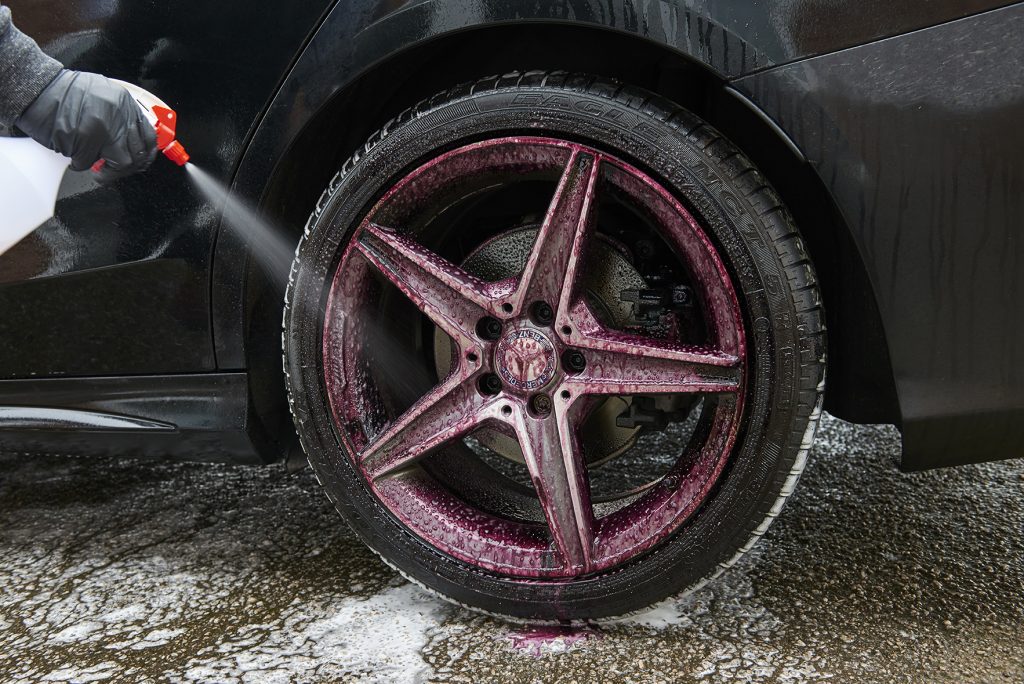Iron Contaminant & Fall Out Removal | A-Chem
What is “fall out” and where does it come from?
Fall out are iron particles that are found on your cars bodywork and wheels, iron particles that become airborne can embed onto vehicles, as they are very sharp (on a microscopic level), they will embed themselves into the paintwork and then oxidise.
Fall out can be generated in many ways, whether it be brake dust from your brake discs, or from any nearby application where there is metal on metal contact – ie a car being transported by train, or parked near a factory where metal works such as grinding is being undertaken.
Why should I remove it?
Fall out which is embedded into the surface will eventually oxidise which then causes rust spots on the vehicle. Not only this, but when the iron particles are rubbed across the surface (when polishing or waxing), this has the potential to cause severe swirl marks. By removing the particles, it will keep your paintwork looking better for longer, but also allow sealants and waxes to adhere to the surface for longer (this is also the case for tar and other contaminants on your paintwork).
How do I remove it?
There are several ways of removing fall out from vehicles, typically the main methods are;
- Clay Bars / Mitt – this is a thorough way of removing fall out, and it will also remove other contaminants which may be on the surface, however, it can be time consuming and easy to miss areas. They are used by applying a clay lube, then gently rubbing the clay across the surface to remove the contamination.
- Oxalic acid based fall out removers – these are more traditionally used and can be very economical in use, they are usually supplied as a concentrate, and are very effective. The downside to these products are that they are applied with typically a low pH, which can be damaging to sensitive trims, but also degrades waxes and sealants. They also give you no indication where you have removed fall out from, and if there is fall out present at all. They are used by spraying the liquid onto the surface, allowing to dwell for a short period of time, then rinsing off.
- “Bleeding fall out removers” – these are based on newer chemistry, and offer a safer and more effective all round product. They react with iron on contact giving a red “bleeding effect”, therefore indicating where contamination is present, but also loosening the iron particle enough to be rinsed off. These product types are typically sold ready to use, they are sprayed on to the surface, allowed to dwell, agitate if necessary and then rinsed. They are very easy and safe to use, and generally pH neutral / balanced which means they are safer on the surfaces than traditional fall out removers.
Myths and Misconceptions
As with all products, there are common misconceptions, especially when products are new to the market. We try to dispel a few of these;
- “Bleeding fall out removers are pH neutral and therefore 100% safe.” While most of the bleeding fall out removers are pH balanced, this doesn’t always mean that they are 100% safe in use. They are a safer alternative to traditional fall out removers and are less likely to cause damage, but they should be used on less frequent basis to wheel cleaners and shampoos, and care is still to be taken on sensitive trims, especially in hot weather or direct sunlight.
- “Bleeding fall out removers are wheel cleaners.” A fall out removers primary function is to remove fall out, not clean general dirt and grim. Certain products may have additional surfactants and other chemicals which enables them to clean wheels and general grime. However, typically, they are not necessary for general cleaning on a weekly basis, as the amount of fall out your car will collect after this period of time is not enough to require the use of a fall out remover.
- “One application is enough.” Usually, the amount of fall out on a vehicle is very little, and therefore, one application of a fall out remover is sufficient to remove all of this. However, in some instances multiple applications will be required – the “bleeding” fall out removers are beneficial when this is the case, as they will stop reacting when applied when all of the fall out has been removed.
What does A-Chem offer?
A-Chem offers a range of products which can remove fall out and decontaminate your vehicles surfaces. We offer clay bars and mitts, traditional fall our removers, as well as the newer “bleeding” fall out removers.
We offer various products under bespoke manufacturing, thickened products for extra dwell time, varying strengths for a range of budgets, as well as other added benefits such as perfumes for reducing the odour (typically very offensive), and dyes in the product for marketing benefits.
See our Bespoke Manufacturing page for further details.
